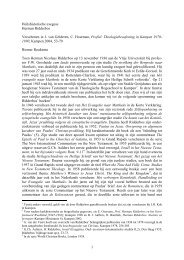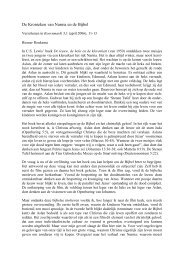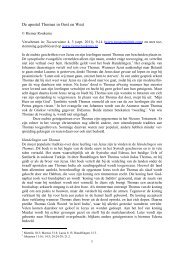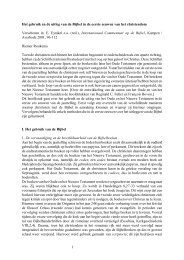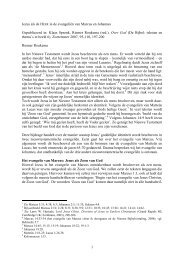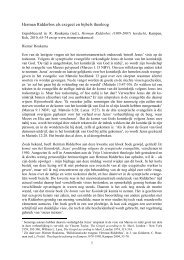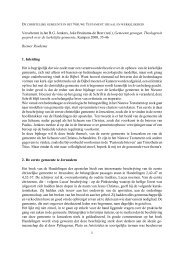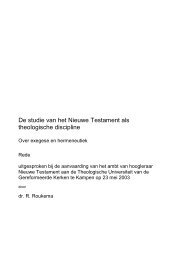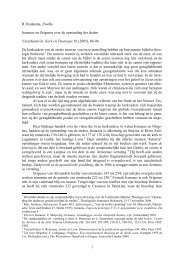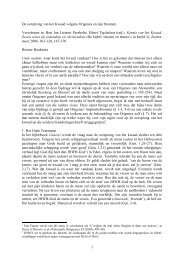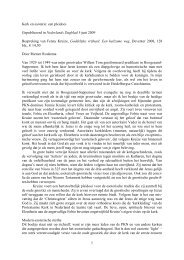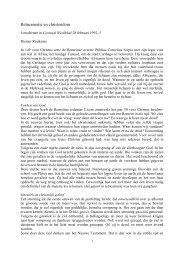Herman Ridderbos‟s Redemptive -historical ... - Riemer Roukema
Herman Ridderbos‟s Redemptive -historical ... - Riemer Roukema
Herman Ridderbos‟s Redemptive -historical ... - Riemer Roukema
Create successful ePaper yourself
Turn your PDF publications into a flip-book with our unique Google optimized e-Paper software.
<strong>Herman</strong> Ridderbos‟s <strong>Redemptive</strong>-<strong>historical</strong> Exegesis of the New<br />
Testament<br />
Published in: Westminster Theological Journal 66 (2004), 259-273<br />
Used with permission<br />
<strong>Riemer</strong> <strong>Roukema</strong> 1<br />
On November 13, 1936, <strong>Herman</strong> Nicolaas Ridderbos obtained his doctorate (with<br />
distinction) at the Free University at Amsterdam under Professor Frederik Willem<br />
Grosheide. His dissertation entitled “The tenor of the Sermon on the Mount according<br />
to Matthew” demonstrated that Ridderbos was a skilful exegete. 2 He was 27<br />
years old at the time, and had been the minister of the Reformed (Gereformeerd)<br />
Church in Eefde-Gorssel (the Netherlands) since 1934. 3 He became minister in<br />
Rotterdam-Charlois in 1939, where in 1941 he finished the first part of his commentary<br />
“The Gospel according to Matthew”. 4 On January 21, 1943, during a period of<br />
great national difficulties, he succeeded Seakle Greijdanus as New Testament professor<br />
at Kampen Theological Seminary. 5 In this function he produced an impressive<br />
amount of publications, the most important of which were also published in English.<br />
Aside from his numerous articles and a few brochures, Ridderbos wrote the books<br />
listed below. 6<br />
In 1946 the second part of “The Gospel according to Matthew” was published<br />
7 . In the same year he published a treatise based on his rectorial address “Selfrevelation<br />
and self-concealment: The <strong>historical</strong> character of Jesus‟ Messianic selfrevelation<br />
according to the Synoptic Gospels”. 8 In 1950, his voluminous work The<br />
Coming of the Kingdom appeared in Dutch. 9 Ridderbos then widened his area of<br />
1 The author is New Testament professor at Kampen Theological University (Koornmarkt / Oudestraat),<br />
the Netherlands. The original version of this paper appeared as “Heilshistorische exegese.<br />
<strong>Herman</strong> Ridderbos” in Profiel. Theologiebeoefening in Kampen 1970 – 1990 (ed. J. van Gelderen<br />
and C. Houtman; Kampen: Uitgeverij Kok, 2004), 53-70. This book was published on occasion of the<br />
150 th anniversary of Kampen Theological University.<br />
2 De strekking der Bergrede naar Mattheüs (Kampen: J. H. Kok, 1936). Titles of Ridderbos‟s books<br />
that have not been translated into English will be given in quotation marks. Books that have been<br />
translated will be referred to according to the title of the English translation (in italics).<br />
3 <strong>Herman</strong> Ridderbos was born on February 13, 1909 in Oosterend (Friesland), the Netherlands.<br />
4 Het Evangelie naar Mattheüs I (Korte Verklaring der Heilige Schrift; Kampen: J. H. Kok, 1941).<br />
5 For more church <strong>historical</strong> and biographical data, see Evert Overeem, Prof. <strong>Herman</strong> Ridderbos en<br />
het Gereformeerd Weekblad [1945-1982] (Kampen: Uitgeverij Kok, 1998); B. Jan Aalbers and<br />
Heinrich Baarlink, <strong>Herman</strong> Ridderbos. Nuchter en bewogen (Kamper Miniaturen 8; Kampen:<br />
Vereniging van Oud-Studenten van de Theologische Universiteit Kampen, 2002).<br />
6 G. van der Veere gives an overview of Ridderbos‟s main publications dating from 1934 to 1978, in<br />
a festschrift presented to Ridderbos, De knechtsgestalte van Christus (ed. H. H. Grosheide e.a.;<br />
Kampen: Uitgeverij Kok, 1978), 256-305.<br />
7 Het Evangelie naar Mattheüs II (Korte Verklaring der Heilige Schrift; Kampen: J.H. Kok, 1946).<br />
8 Zelfopenbaring en zelfverberging. Het historisch karakter van Jezus’ messiaansche zelfopenbaring<br />
volgens de synoptische evangeliën (Kampen: J. H. Kok, 1946).<br />
9 De komst van het Koninkrijk. Jezus’ prediking volgens de synoptische evangeliën (Kampen: J. H.<br />
Kok, 1950). English translation: The Coming of the Kingdom (ed. Raymond O. Zorn, transl. H. de<br />
Jongste; Philadelphia Pa: The Presbyterian and Reformed Publishing Company, 1962).<br />
1
esearch and in 1952 he published Paul and Jesus: Origin and General Character of<br />
Paul’s Preaching of Christ 10 (in Dutch), a book he characterized as “an introduction<br />
to Paul”. 11 In 1953 his research into this apostle took shape in yet another work on<br />
Paul, a commentary in English entitled The Epistle of Paul to the Churches of<br />
Galatia. 12 In 1955 he published a paper “Israel in the New Testament, especially<br />
according to Rom. 9-11”. 13 During the same year, he published <strong>Redemptive</strong> History<br />
and the New Testament Scriptures (in Dutch). 14 This was followed by a book in<br />
English which was based on earlier works and was published in 1957 under the title<br />
When the Time had Fully Come: Studies in New Testament Theology. 15 In 1958 he<br />
published a modest book in English about a theme with which he was well acquainted,<br />
Matthew’s Witness to Jesus Christ: The King and the Kingdom. 16 During those<br />
years he must have devoted most of his time to preparations for his thoroughly<br />
written commentary on Paul‟s Epistle “To the Romans”, which was published in<br />
1959. 17 Only a year later he completed his commentary “To the Colossians”. 18<br />
Ridderbos‟s next book did not appear until 1966, but this was the most voluminous<br />
work he ever published: Paul: An Outline of his Theology (in Dutch). 19 A year later<br />
his commentary “The Pastoral Epistles” was published. 20 During the celebrations of<br />
the 25 th anniversary of his professorship in 1968, his colleagues presented him with<br />
a collection of a number of his articles and lectures, entitled “The Word, The Kingdom,<br />
and our Embarrassment”. 21 In 1972 he became involved in the controversy<br />
about <strong>Herman</strong> Wiersinga‟s dissertation “Reconciliation in the theological discussion”.<br />
22 Ridderbos‟s response is entitled “Are We on the Wrong Way? A Biblical<br />
10<br />
Paulus en Jezus. Oorsprong en algemeen karakter van Paulus’ Christus-prediking (Kampen: J. H.<br />
Kok, 1952). English Translation: Paul and Jesus: Origin and General Character of Paul’s Preaching<br />
of Christ (transl. D. H. Freeman; Philadelphia Pa: The Presbyterian and Reformed Publishing<br />
Company, 1958).<br />
11<br />
Only in the Dutch edition, p. 5.<br />
12<br />
In The New International Commentary on the New Testament; Grand Rapids: William B. Eerdmans<br />
Publishing Company, 1953.<br />
13<br />
“Israël in het Nieuwe Testament, in het bijzonder volgens Rom. 9-11” in G. Ch. Aalders and H.<br />
Ridderbos, Israël (Exegetica. Oud- en nieuw-testamentische studiën II, 2; Den Haag: Van Keulen,<br />
1955), 23-73.<br />
14<br />
Heilsgeschiedenis en Heilige Schrift van het Nieuwe Testament. Het gezag van het Nieuwe Testament<br />
(Kampen: J. H. Kok, 1955). English translation: The Authority of the New Testament Scriptures<br />
(transl. H. de Jongste; Philadelphia Pa: The Presbyterian and Reformed Publishing Company, 1963;<br />
revision: <strong>Redemptive</strong> History and the New Testament Scriptures (revision R. B. Gaffin, Jr.; Phillipsburg,<br />
N.J.: The Presbyterian and Reformed Publishing Company, 1968; 2 nd revised ed., 1988).<br />
15<br />
Grand Rapids Mi: William B. Eerdmans Publishing Company, 1957.<br />
16<br />
World Christian Books 23; London: United Society for Christian Literature Lutterworth Press,<br />
1958. This book was published in Dutch in the same year: Het verborgen Koninkrijk. Handleiding tot<br />
het Evangelie van Mattheüs (Kampen: J. H. Kok, 1958).<br />
17<br />
Aan de Romeinen (Commentaar op het Nieuwe Testament; Kampen: J. H. Kok, 1959).<br />
18<br />
This commentary came out in one volume with F. W. Grosheide‟s commentary on the Epistle to<br />
the Ephesians: Aan de Efeziërs. Aan de Colossenzen (Commentaar op het Nieuwe Testament;<br />
Kampen: J. H. Kok, 1960)<br />
19<br />
Paulus. Ontwerp van zijn theologie (Kampen: J. H. Kok, 1966). English translation: Paul: An<br />
Outline of his Theology (transl. J. R. De Witt; Grand Rapids Mi: William B. Eerdmans Publishing<br />
Company, 1975).<br />
20<br />
De Pastorale brieven (Commentaar op het Nieuwe Testament; Kampen: J. H. Kok, 1967).<br />
21<br />
Het Woord, het Rijk en onze verlegenheid (Kampen: J. H. Kok, 1968).<br />
22<br />
De verzoening in de theologische diskussie (Kampen: J. H. Kok, 1971).<br />
2
Study of Reconciliation”. 23 After this, it was a number of years before another work<br />
of his was published. Ridderbos officially retired in 1975, but he kept his chair until<br />
1978. In this year a collection of six papers was published in English entitled Studies<br />
in Scripture and its Authority. 24 During those years, he devoted his research to the<br />
Gospel of John. 25 His valedictory lecture was published in 1979, entitled “The Word<br />
Became Flesh: Reflections on the Unique Character of the Gospel of John”. 26 In<br />
1987 he finished the first volume of The Gospel of John: A Theological Commentary<br />
(in Dutch). The second volume followed in 1992, completing Ridderbos‟s<br />
theological body of work. 27 In 1999 he wrote his last booklet, a biography of his<br />
father, who had been Old Testament professor at Kampen from 1913 until 1950. 28<br />
In addition to these, the reprints of several of his works deserve to be mentioned,<br />
as do the translations of his works into German, Spanish, Portuguese,<br />
Danish, Korean and Indonesian. If we add to these the 1750 or so opinion articles he<br />
wrote in Gereformeerd Weekblad (“Reformed Weekly”) between 1945 and 1982, as<br />
well as his many other articles that were included in other periodicals and collections<br />
in the Netherlands and abroad, it is clear that Ridderbos was a very productive<br />
and versatile writer, whose authority was, and still is, recognized in many countries.<br />
This article is devoted to one particular aspect of Ridderbos‟s work that<br />
appears in nearly all his books and is characteristic of his theology. He regularly<br />
pointed out that the New Testament should be interpreted “redemptive-<strong>historical</strong>ly”<br />
(or: “salvation-<strong>historical</strong>ly”). The terms “redemptive-<strong>historical</strong>” and “redemptive<br />
history” or “salvation history” are less prevalent in theological works of the beginning<br />
of the twenty-first century than in Ridderbos‟s body of work, and where they<br />
are being used they do not always carry the same meaning as they do in his publications.<br />
We will therefore look at what Ridderbos meant with the term “redemptive<strong>historical</strong><br />
exegesis” and from which he wished to distinguish his own approach.<br />
In order to place his view on redemptive-<strong>historical</strong> exegesis in its context, we<br />
will first consider the origin of the term “redemptive history”, and describe how it<br />
functioned in the Reformed Churches in the Netherlands during the first few decades<br />
of the twentieth century.<br />
<strong>Redemptive</strong> history as a theological theme<br />
The source of the term “redemptive history” is supposed to be the theologian J. C.<br />
K. von Hofmann, who taught in Erlangen (Germany). Around the middle of the<br />
23 Zijn wij op de verkeerde weg? Een bijbelse studie over de verzoening (Kampen: J. H. Kok, 1972).<br />
24 Grand Rapids Mi: William B. Eerdmans Publishing Company, 1978.<br />
25 He had expressed his scientific interest for this Gospel earlier in his speech of December 8, 1965,<br />
“Opbouw en strekking van de proloog van het evangelie van Johannes”, included in Het Woord, het<br />
Rijk en onze verlegenheid, 37-57, and published under the title “The structure and scope of the Prologue<br />
to the Gospel of John” in Placita Pleiadia. Opstellen aangeboden aan Prof. Dr. G. Sevenster<br />
(Leiden: E. J. Brill, 1966) = Novum Testamentum 8 (1966): 180-201.<br />
26 Het Woord is vlees geworden. Beschouwingen over het eigen karakter van het Evangelie van<br />
Johannes (Kampen: J. H. Kok, 1979).<br />
27 Het Evangelie naar Johannes. Proeve van een theologische exegese I-II (Kampen: J. H. Kok, 1987,<br />
1992). English translation: The Gospel of John: A Theological Commentary (transl. John Vriend;<br />
Grand Rapids Mi / Cambridge U.K.: William B. Eerdmans Publishing Company, 1997).<br />
28 Jan Ridderbos. Mens (Kamper Miniaturen 4; Kampen: Vereniging van Oud-Studenten van de<br />
Theologische Universiteit Kampen, 1999).<br />
3
nineteenth century he endeavored to demonstrate from the Scriptures the steady<br />
<strong>historical</strong> development of God‟s communion with humankind. He exposited the<br />
Scriptures on the basis of the scheme Weissagung und Erfüllung (“Prophecy and<br />
Fulfillment”), which was the title of his two volumes from 1841-1844, 29 and he<br />
viewed Christ as the center of history and the beginning of its completion. The<br />
Christian partakes in this redemptive history (Heilsgeschichte) by being born again.<br />
Hofmann opposed his “redemptive-<strong>historical</strong>” (heilsgeschichtlich) exposition to the<br />
dogmatic use of Scriptures, which implied that the Bible serves as a collection of<br />
proof texts for Christian doctrine. 30<br />
Hofmann was not the first to pay attention to the <strong>historical</strong> character of<br />
God‟s plan of redemption that enfolds from Creation to the End of times. In fact,<br />
Irenaeus of Lyons designed a redemption-<strong>historical</strong> theology around the year 180. 31<br />
Hofmann‟s attempt to free the Bible from its one-sided dogmatic usage is similar to<br />
J. P. Gabler‟s proposal in 1787 to develop a “Biblical theology” as opposed to<br />
“Dogmatic theology”. 32<br />
Abraham Kuyper, however, rejected Gabler‟s term “Biblical theology”,<br />
partly because it appeared to suggest that the Bible writers had a theology and<br />
worked as theologians, whereas they were first and foremost inspired by the Holy<br />
Spirit. 33 Kuyper therefore suggested that that which Gabler refers to should be called<br />
historia revelationis (history of revelation).<br />
A similarly negative judgement concerning the “redemptive-<strong>historical</strong><br />
method” as proposed by Hofmann was formulated by F. W. Grosheide. 34 He felt it<br />
contains some good elements, but because Hofmann did not view the Scriptures as<br />
<strong>historical</strong>ly completely accurate and also found “the work of man” in it, Grosheide<br />
dismissed his approach.<br />
As a result of this, the subject historia revelationis was taught at the theological<br />
faculty of the Free University at Amsterdam and also at Kampen Theological<br />
Seminary. At Kampen the subject was taught by Old Testament professor Jan Ridderbos.<br />
<strong>Herman</strong> Ridderbos stated in 1994 that what is now called Biblical theology<br />
was then called historia revelationis. 35<br />
29<br />
Weissagung und Erfüllung im alten und im neuen Testamente. Ein Theologischer Versuch I-II<br />
(Nördlingen: C. H. Beck‟sche Buchhandlung, 1841, 1844).<br />
30<br />
See Gustav Weth, Die Heilsgeschichte. Ihr universeller und ihr individueller Sinn in der offenbarungsgeschichtlichen<br />
Theologie des 19. Jahrhunderts (Munich: Kaiser, 1931), 81-94; K. G. Steck,<br />
Die Idee der Heilsgeschichte. Hofmann – Schlatter – Cullmann (Zollikon: Evangelischer Verlag,<br />
1959), 19-35.<br />
31<br />
See P. L. Wansink, Irenaeus en het Oude Testament. Gnostische en heilshistorische exegese in de<br />
tweede eeuw (Zoetermeer: Boekencentrum, 2000).<br />
32<br />
For this see Hendrikus Boers, What is New Testament Theology? The Rise of Criticism and the<br />
Problem of a Theology of the New Testament (Philadelphia: Fortress Press, 1979), 23-38, and Ed<br />
Noort, “Tussen geschiedenis en theologie. Over valkuilen en mogelijkheden in de bijbelse theologie”<br />
Kerk en Theologie 53 (2002): 202-23, esp. 203-7.<br />
33 nd<br />
Encyclopaedie der heilige Godgeleerdheid III (Kampen: J. H. Kok, 1909, 2 ed.), 166-80.<br />
34<br />
Hermeneutiek ten dienste van de bestudeering van het Nieuwe Testament (Amsterdam: Van<br />
Bottenburg, 1929), 120-1.<br />
35<br />
In Gerrit Douma, “Een theologische gemeenschap ten dienste van de kerk. Een gesprek over de<br />
school met prof. dr. <strong>Herman</strong> Ridderbos” Communiqué 11, 2 (1994): 4-16, esp. 7; also in <strong>Herman</strong><br />
Ridderbos, Jan Ridderbos. Mens, 10.<br />
4
However, not all Reformed theologians shared Grosheide‟s rejection of the<br />
redemptive-<strong>historical</strong> interpretation of Scriptures. Tjeerd Hoekstra, Practical Theology<br />
professor at Kampen, candidly spoke of “the redemptive history of the Old<br />
Testament” when discussing the historia revelationis in his “Reformed Homiletics”.<br />
36 A very important figure in this respect is Klaas Schilder, who in 1934 became<br />
Dogmatics and Ethics professor at Kampen. Even as a minister of religion he had<br />
started around the year 1930 to criticize the “exemplary sermons” on the <strong>historical</strong><br />
texts in the Bible. In this style of preaching Biblical figures were used as examples<br />
for the hearers, but Schilder felt that this meant that the role these people played in<br />
redemptive history was not sufficiently recognized. 37 He compared redemptive<br />
history from Creation until Christ‟s return to the alphabet that runs from A to Z, and<br />
also with a clock indicating in which part of time a particular event takes place.<br />
Schilder felt that in order to accurately exposit a biblical passage one would need to<br />
know its position in redemptive history. He not only contrasted redemptive-<strong>historical</strong><br />
preaching with exemplary preaching, but also with the one-sided attention for<br />
the subjective experience of faith as taught in the pietistic tradition of the Dutch<br />
“Further Reformation”, and also by the Darbists and in the Pentecostal movement. 38<br />
Against the individualistic and psychological interpretation of redemptive history,<br />
which taught that what matters most is not Christmas, Easter and Pentecost, but<br />
Christ‟s birth in our hearts, Schilder pointed to the <strong>historical</strong> redemptive facts. He<br />
also contrasted this accent with ethical and dialectic theology.<br />
Early works (1936-1946)<br />
We will now return to <strong>Herman</strong> Ridderbos and see how he wrote about redemptive<br />
history in these and related terms.<br />
In his doctoral dissertation “The Tenor of the Sermon on the Mount according<br />
to Matthew” (1936) he refers as early as on p. 4 to the discussions that took<br />
place at the time. Ridderbos points to the great interest in, and authority of, the<br />
Sermon on the Mount, but also states that its importance should not be made<br />
absolute, because revelation passes through history, which did not finish with the<br />
Sermon on the Mount. In mentioning the “history of revelation” he adopts Kuyper‟s<br />
terminology. In the first chapter he argues that the Sermon on the Mount gives a<br />
picture of the first stage of Jesus‟ ministry. It is interesting that this view barely<br />
surfaces in the remainder of the dissertation. Ridderbos discusses the consequently<br />
immanent and the consequently eschatological views on the Kingdom of God that<br />
were defended at the time in relation to the Sermon on the Mount, and also the<br />
interpretations in between those two extremes (70-182). He distances himself from<br />
the “Sermon on the Mount Christianity” as advocated by Mennonites, religious<br />
socialists and pacifists (199-204). Ridderbos disputes the view that each commandment<br />
from the Sermon on the Mount has unlimited validity, and argues that the<br />
commandments given in the Sermon on the Mount are illustrations of the command-<br />
36 Gereformeerde homiletiek (Wageningen: Zomer en Keuning, 1926), 221.<br />
37 See Klaas Runia, Het hoge woord in de lage landen (Kampen: Uitgeverij Kok, 1985), 116-24. He<br />
describes Schilder as “the father of redemptive-<strong>historical</strong> teaching”.<br />
38 C. Trimp, Heilsgeschiedenis en prediking. Hervatting van een onvoltooid gesprek (Kampen:<br />
Uitgeverij Van den Berg, 1986), 57-65, even distinguishes eleven aspects of Schilder‟s view on<br />
redemptive-<strong>historical</strong> teaching.<br />
5
ment to love. He believes that the sometimes paradoxical mode of expression must<br />
be judged on its character and that exceptions to Jesus‟ commandments are not<br />
impossible (242-7). However, he does not offer any explicit indications of where the<br />
Sermon on the Mount fits into redemptive history. Instead, he states that the fundamentals<br />
of the Sermon on the Mount must be traced in the light of continued revelation<br />
(251); with this he means “the development of revelation” throughout Jesus‟<br />
life. 39 Even though he rejects “unscriptural radicalism”, he recognizes that social and<br />
international justice flow from the tenor of the Sermon on the Mount (251) and that<br />
the kingdom proclaimed in the Sermon on the Mount desires to be revealed everywhere<br />
(255-6).<br />
The reason that Ridderbos did not yet use the terms “redemptive history” and<br />
“redemptive-<strong>historical</strong>” when writing his dissertation, may be that his tutor Grosheide<br />
was dismissive of them. But even apart from these terms, it is clear that at this<br />
time he did not yet have a detailed view on redemptive-<strong>historical</strong> exegesis.<br />
In the first part of his exposition of the Gospel of Matthew (1941) he does<br />
use these terms, but in an inconspicuous way. For instance, he states with Matthew<br />
1:1 “that in the birth of Jesus Christ, the overall redemptive-<strong>historical</strong> line is continued<br />
and that this birth is therefore fully in accordance with the prophecy and expectation<br />
of the Jewish nation regarding the coming Messiah”. 40<br />
In his paper “Self-revelation and self-concealment” (1946) he discusses why,<br />
according to the Synoptic Gospels, Jesus refused to be called the Messiah during his<br />
lifetime. According to William Wrede, Jesus never believed he was the Messiah,<br />
and according to Albert Schweitzer Jesus‟ Messiahship lay in the future. Ridderbos<br />
rejects both interpretations and states that “it is the task of exegesis and of historia<br />
revelationis to understand the preaching of Christ in the Gospel in its own character<br />
and tenor” (26-7). He recognizes that the Gospels are “<strong>historical</strong> tendentious writings,<br />
not produced in the first place with the aims of a historian but with those of an<br />
evangelist” (29). Thus the Christological perspective sometimes displaces the <strong>historical</strong><br />
one (32). However, Ridderbos believes that “it cannot be denied that the picture<br />
which the Gospels give us of Jesus‟ revelation of himself as the Christ was determined<br />
by the history of Jesus’ life on earth”, which means that there is no room for<br />
“an antedated picture of the exalted Christ” (39-40; italics H. N. R.). At the same<br />
time, he recognizes that Jesus “nowhere acts among the people claiming to be the<br />
Christ” (41). He even finds the theme of Jesus‟ self-concealment in the Gospel of<br />
John, even though John‟s Christ-kerygma considerably differs from that of the<br />
Synoptics in other respects (66-9). Ridderbos believes that the command of secrecy<br />
flows from the character of Jesus‟ Messiahship, since the Gospels always link it to<br />
his suffering and death (77). He points to the Old Testament background of the<br />
Suffering Servant (79) and remarks that even in his suffering and death, Jesus was,<br />
and needed to be, the hidden Christ, until the very end (83). Eventually he starts<br />
discussing the “redemptive-<strong>historical</strong> meaning and effect” of Jesus‟ suffering and<br />
death. With this he means to say that irrespective of what people understand about<br />
Jesus‟ suffering and death, it has “an objective and forensic meaning”. “After all,<br />
what is taking place is unknown until after it has taken place. It lies behind that<br />
39 This can be deduced from his exposition in Het Evangelie naar Mattheüs I, 83.<br />
40 Het Evangelie naar Mattheüs I, 19. See also p. 217 (with Mt. 11:12) and p. 290 (with Mt. 16:2-3).<br />
6
which a human being can distinguish in it. And therefore that which takes place<br />
between Jesus and the Father, between the Messiah and his God, is what determines<br />
the meaning and character of his suffering and death.” (84; italics H. N. R.). He<br />
continues by pointing to Mark 10:45 and 14:24 as texts that deal with Jesus‟<br />
vicarious death, in which “lies the meaning of his hidden Messianic passion” (84).<br />
This is the first time that Ridderbos explicitly speaks of the “redemptive<strong>historical</strong>”<br />
meaning of Jesus‟ suffering and death. From this moment onward, the<br />
term will take a central place in his work.<br />
The Coming of the Kingdom (1950 in Dutch)<br />
In his book The Coming of the Kingdom Ridderbos repeatedly uses the term<br />
“redemptive-<strong>historical</strong>”. In the introduction he explains why. In earlier books he<br />
responded to the nineteenth and early twentieth century liberal views of Jesus. He<br />
valued some elements of these views, for instance Albert Schweitzer‟s renewed<br />
emphasis on the eschatological character of Jesus‟ teaching. Ridderbos felt, however,<br />
that Schweitzer had swung too much toward the other extreme. Neither did he<br />
feel comfortable with Karl Barth‟s and Rudolf Bultmann‟s existentialistic interpretations,<br />
again in spite of a partial appreciation of these. Ridderbos found a<br />
kindred spirit in Oscar Cullmann, who taught in Strasburg, Paris, and Basel, and<br />
who strongly inspired him. Cullmann argues in his book Christus und die Zeit. Die<br />
Urchristliche Zeit- und Geschichtsauffassung, published in 1946, 41 that the linear<br />
view of time is a characteristic of Biblical eschatology and soteriology. 42 He regards<br />
redemptive history as the core of New Testament preaching and is of the opinion<br />
that whoever denies this, opposes himself to the teachings of Christianity. Cullmann<br />
rejects the reconstructions of exegetes such as Schweitzer and Bultmann, because<br />
redemption as proclaimed in the Gospel of Christ is linked to a continuous event<br />
spanning past, present, and future. “It was as if I had been waiting for this”, Ridderbos<br />
later commented. 43 Furthermore, it became clear during this time that other<br />
exegetes were also of the view that the kingdom that Jesus preached was both<br />
present and future, and had therefore not merely arrived either immanently or<br />
eschatologically. Ridderbos mentions the names of J. Jeremias, E. Stauffer, H. M.<br />
Matter and W. G. Kümmel, amongst others (xxviii).<br />
This development forms the background to his book The Coming of the<br />
Kingdom, in which Ridderbos states: “That which Jesus preaches is not a timeless<br />
truth, and what he brings is not only a new spirituality, a new disposition. No more<br />
is it a new form of society (in the sense of the social gospel) or an action carried on<br />
by men and slowly developing to its consummation. The coming of the kingdom of<br />
God is most certainly to be looked upon as the realization of the great drama of the<br />
history of salvation in the sense of the Old Testament and of the Jewish apocalypses.<br />
This realization is not merely a matter of the future, however. It has started. The<br />
41 Zürich-Zollikon: Evangelischer Verlag, 1946. English translation: Christ and Time: The Primitive<br />
Christian Conception of Time and History (transl. Floyd V. Filson; London: S. C. M. Press, 1951; 3 rd<br />
rev. ed. Philadelphia: The Westminster Press, 1975).<br />
42 See also Cullmann‟s paper Le retour du Christ. Espérance selon le Nouveau Testament (Neuchâtel<br />
/ Paris: Delachaux et Niestle, 1945, 2 nd ed.), mentioned by Ridderbos.<br />
43 In a conversation with the author on January 13, 2004.<br />
7
great change of the aeons has taken place. The center of history is in Christ‟s<br />
coming, in his victory over the demons, in his death and resurrection” (xxviii).<br />
After two chapters on the Old Testament, Judaism, and John the Baptist,<br />
Ridderbos describes in chapters 3 to 7 in what sense the kingdom of heavens had<br />
arrived with Jesus‟ coming according to the Synoptic Gospels. The titles of some of<br />
his paragraphs are: The Wicked One Overcome, Jesus‟ Power to Work Miracles,<br />
Speaking in Parables, The Delay of the Judgment, The Servant of the Lord, The<br />
Kingdom and the Cross, The Gospel of the Poor, Remission of Sins, The Fatherhood<br />
of God, The Fulfillment of the Law, The Application of the Demand of Love.<br />
Ridderbos not only speaks of fulfillment here, but also of its provisional character.<br />
To him, „[t]he kingdom has come, and yet the fulfillment is in abeyance‟ (106).<br />
Chapter 8 is devoted to the coming of the kingdom and the church. In<br />
contrast to liberal exegetes, Ridderbos assumes that Jesus‟ sayings about the church<br />
in Matthew 16:18-19 and 18:15-17 are authentic (334-42). He rejects the idea that<br />
Jesus expected the imminent full arrival of God‟s kingdom and that the first Christians<br />
were disappointed about its delay. We see, therefore, that Ridderbos‟s redemptive-<strong>historical</strong><br />
view leaves room for the church as intended by Jesus.<br />
In chapter 9, which discusses the coming of the kingdom and the Lord‟s<br />
Supper, he argues that “the specific redemptive-<strong>historical</strong> significance of this Supper<br />
is not to be sought primarily in the eschatological perspective disclosed by Jesus, but<br />
much rather, in connection with Jesus‟ expiatory death” (416). He does not regard<br />
the Lord‟s Supper as a resurrection meal, but as a sacrificial expiatory meal of which<br />
Good Friday is the focal point (431-2).<br />
Finally, in chapter 10 he gives a detailed discussion of the Naherwartung<br />
(i.e., the imminence of the Kingdom) as observed in the New Testament. Ridderbos<br />
recognizes that the Synoptic Gospels contain “direct eschatological pronouncements”<br />
by Jesus that seem to suggest the imminent coming of the kingdom (e.g.<br />
Matthew 10:23; Mark 9:1; 13:30). Exegetes such as Schweitzer have taken those<br />
texts seriously and deduced from them that Jesus was mistaken as regards the<br />
imminent general arrival of God‟s kingdom. To Ridderbos, the idea that Jesus could<br />
have been mistaken is out of the question. With reference to Cullmann and others he<br />
emphasizes that Christ‟s death and resurrection have brought the preliminary fulfillment<br />
of the coming of the Kingdom of heavens, followed by a “time of grace”<br />
which will last until the parousia. His conclusion is that Jesus did not try to give the<br />
impression that he would come back soon, but that a longer term was possible, or at<br />
least that he did not indicate a specific time (514-6; 523).<br />
It is clear from Ridderbos‟s reflections on this issue that he found it difficult<br />
to do justice to the passages that seem to suggest an imminent end. The term<br />
“redemptive-<strong>historical</strong>” is conspicuously absent from the final chapter.<br />
With hindsight it can be maintained that he gave a reliable picture of the<br />
theology of the Synoptic Gospels as regards their view of the future. To Ridderbos,<br />
however, the theology of the Synoptics largely matches Jesus‟ own preaching.<br />
Ridderbos was aware of the view that when Jesus‟ preaching was committed to<br />
writing the experiences of the early Christian church were incorporated, but he<br />
rejected it.<br />
8
<strong>Redemptive</strong> History and the New Testament Scriptures (1955 in Dutch)<br />
In <strong>Redemptive</strong> History and the New Testament Scriptures Ridderbos shows what the<br />
implications are of his view on redemptive history for the origin and the authority of<br />
the New Testament canon. He argues that the history of the canon is part of church<br />
history and not of redemptive history (12; 16). 44 Nevertheless, he argues that the<br />
authority of the New Testament canon is rooted in redemptive history, i.e. in Christ.<br />
In his view, “Christ established a formal authority structure to be the source and<br />
standard for all future preaching of the gospel” (13; italics H. N. R.). This implies<br />
that Christ wished his apostles to pass on – orally and in writing – that which took<br />
place in the fullness of time (Galatians 4:4). Ridderbos therefore speaks of “continuing<br />
revelation” (15). The writings of the apostles include the written record of the<br />
oral tradition, which is borne by the exalted Christ (15-22). Ridderbos also refers to<br />
inspiration by the Holy Spirit (14; 29-30). He defends the intended closed character<br />
of the canon (25-30). He maintains that not all New Testament writings need to be<br />
written by apostles, but that the important thing is that they contain the apostolic<br />
tradition (32). He argues that the canon in its redemptive-<strong>historical</strong> meaning is not<br />
the product of the Christian community, but rather that the Christian community is<br />
destined to be the product of this canon (25). Thus the canon has produced the<br />
church (40).<br />
In setting out his arguments, he appeals to Cullmann several times. 45 It is<br />
clear that Ridderbos‟s view that the establishment of the canon was intended by<br />
Christ correlates with his view that Christ did not intend to give the impression that<br />
He would come back soon. In this view there is therefore a time for the church, and<br />
Christ did not only leave his Spirit, but also the New Testament canon.<br />
After arguing the place the New Testament canon takes in redemptive history<br />
and thereby in Christ‟s will of intention, Ridderbos discusses the character of the<br />
authority of the New Testament. On the one hand he states that the one thing that<br />
will make or break the authority of the New Testament message is the factuality of<br />
the <strong>historical</strong> events which it proclaims (55). On the other hand he sees that the<br />
gospel writers wrote with relative freedom in presenting the witness they had<br />
received and in their use of each other‟s writings (66). He qualifies the authority of<br />
the New Testament scriptures as follows: “The New Testament is not a book of<br />
revelation in the sense that all of its pronouncements intend, directly or indirectly, to<br />
give answers to the questions with which life confronts us” (57). The New Testament‟s<br />
teaching “is certainly not intended to provide us with all sorts of theoretical<br />
and practical teaching or insight, which as such do not proceed from the revelation<br />
of God in Jesus Christ” (74). Ridderbos then points at the redemptive-<strong>historical</strong><br />
character of the knowledge that the New Testament imparts (75). It becomes<br />
apparent that the term “redemptive-<strong>historical</strong>” here obtains a restrictive meaning as<br />
regards the fundamentalist interpretation of Scriptures, according to which not only<br />
44 The references are given to the pages in the second revised translation (cf. n. 14).<br />
45 Yet Cullmann also places accents that differ from Ridderbos. For instance, in La Tradition.<br />
Problème exégétique, historique et théologique (Neuchâtel / Paris: Delachaux et Niestle, 1953), 43,<br />
he states : “Nous sommes absolument d‟accord avec la théologie catholique lorsqu‟elle insiste sur le<br />
fait que l‟Eglise elle-même a fait le Canon” (“We absolutely agree with Catholic theology where it<br />
insists that the Church itself made the Canon.”) (italics O. C.).<br />
9
the redemptive facts, but also many other details should be accepted as <strong>historical</strong><br />
facts.<br />
Works on the apostle Paul (1952-1966)<br />
In Ridderbos‟s interpretation of the Pauline Epistles we see a different aspect of the<br />
term “redemptive-<strong>historical</strong>” becoming apparent. In his work Paul and Jesus (1952<br />
in Dutch) he remarks: “Under the influence of the basic theme of the Reformation,<br />
justification by faith was for a long time viewed as the actual content of Paul‟s<br />
gospel, around which all the other elements of his epistles were grouped” (63).<br />
Ridderbos recognizes that justification by faith is part of the core of Paul‟s preaching<br />
and is not a secondary “polemic” directed against the Jews (as taught by Wrede),<br />
or a “side-issue within the main stream of the mystical doctrine of redemption of<br />
„being in Christ‟” (as taught by Schweitzer). Yet Ridderbos observes that “by<br />
approaching Paul‟s doctrine exclusively from the standpoint of justification by faith<br />
there is a danger of depriving Paul‟s preaching of its redemptive <strong>historical</strong> dynamic<br />
and of making it into a timeless treatment of the vital question: how is one justified<br />
before God?” (63). After all, whoever attempts to understand Paul from the perspective<br />
of this personal question, loses sight of the fact that Paul knew himself to be the<br />
herald of the “fullness of time” and of the new things that had arrived in the framework<br />
of time through Christ (63-4).<br />
This emphasis on redemptive history is a regular feature in his commentaries<br />
on the Pauline epistles. Ridderbos points out that Paul wrote about the history of<br />
God‟s involvement with Israel and humankind, starting with Adam, Abraham,<br />
Moses and the prophets and culminating in the salvation that appeared in Christ. 46<br />
This implies that when Paul writes about baptism, he does not in the first place talk<br />
about a mystical or ethical renewal of man, but about a renewal in the redemptive<strong>historical</strong><br />
and eschatological sense. This means that the person who is being baptized<br />
is being incorporated into something that has taken place in Christ once and for<br />
all. Ridderbos uses the term “corporate” (Aan de Romeinen, 114, 125) to describe<br />
this; he means by this that the believer is part of a collective that was first ruled by<br />
sin and later saved by Christ. In doing this he attempts to shift the focus away from a<br />
mystical interpretation of Paul that is concerned with the spiritual development of<br />
the individual. According to Ridderbos, the apostle was not concerned with the<br />
spiritual or mystical experience of the individual in baptism, or with a scheme for<br />
spiritual progress and the determination of growth in moral conduct. In his view,<br />
Paul places the emphasis on that which the believer has received in Christ, without<br />
explicitly being concerned with the believer‟s personal experiences. Or, in Ridderbos‟s<br />
own words: “The corporate, redemptive-<strong>historical</strong> viewpoint explains both the<br />
forensic and the ethical salvation from sin” (Aan de Romeinen, 125). His emphasis<br />
on the redemptive-<strong>historical</strong> interpretation of Paul is so strong that in discussing the<br />
“strong” and the “weak” in Romans 14, he remarks that there Paul does not write<br />
from a redemptive-<strong>historical</strong> viewpoint but from a pastoral one (Aan de Romeinen,<br />
302). 47<br />
46 For instance, The Churches of Galatia, 129, 135, 137, 147-8; Aan de Romeinen, 20, 81, 98, 112,<br />
124, 125, 128, 129, 134, 135, 203, 251, 261; Aan de Kolossenzen, 181, 203, 205-6.<br />
47 In Paul, 321, he makes a similar remark about Paul‟s admonition regarding the authorities in<br />
Romans 13.<br />
10
In his monumental book Paul (1966 in Dutch) Ridderbos confirms that his<br />
redemptive-<strong>historical</strong> interpretation, which he links with Luther and Calvin, is<br />
opposed to the emphasis on what he here calls the “order of salvation” (or: “redemptive<br />
order”), whereby he has pietism, mysticism and moralism in mind. In the<br />
“redemptive order” interpretation of Paul, “the emphasis shifted to the process of<br />
individual appropriation of the salvation given in Christ and to its mystical and<br />
moral effect in the life of believers” (14). With approval he quotes two sentences<br />
from Wrede‟s conclusions: “That which is peculiar to Paul and also new in him is<br />
this, that he made redemptive facts – the incarnation, the death, and the resurrection<br />
of Christ – the foundation of religion. <strong>Redemptive</strong> history is the backbone of Pauline<br />
Christianity” (21). 48<br />
This redemptive-<strong>historical</strong> view on Paul is Ridderbos‟s instrument by which<br />
he distinguishes himself from the religionsgeschichtlich (history of religions)<br />
approach and also from Schweitzer‟s mystical interpretation. Against Bultmann‟s<br />
demythologizing interpretation of eschatology and his existentialistic reading of<br />
Paul he argues that such a vision leaves no room for “an eschatological redemptive<br />
history in the sense of a train of events advancing toward the consummation which<br />
have already taken place and are still to be anticipated in Christ” (42). In Ridderbos‟s<br />
view, this emphasis on the redemptive-<strong>historical</strong> and corporate as against the<br />
individual and mystical does not find its determinative point of departure in the new<br />
creature but in the new creation. For instance, he interprets 2 Corinthians 5:17 as<br />
follows: “If any man is in Christ, he is [belongs to] the new creation. The old things<br />
have passed away, behold! New things have come”. According to Ridderbos this<br />
does not in the first place concern the individual regeneration, the individual past<br />
and the personal renewal (206). Similarly, “being in the Spirit” denotes not a subjective<br />
state of consciousness, but an “objective” mode of being (221).<br />
As in earlier works, Ridderbos stresses in his interpretation of Paul that<br />
God‟s promises have been fulfilled: “Behold, now is the acceptable time; behold,<br />
now is the day of salvation” (2 Corinthians 6:2). In this he distinguishes between the<br />
“already” and the “not yet” (487). He does however recognize that Paul did not<br />
make allowance for a centuries-long continuing development of the present world<br />
order (489). 49 He points out that on the one hand the apostle writes, “the time is<br />
short” (1 Corinthians 7:29), and on the other hand he warns against an over-excited<br />
Naherwartung in 2 Thessalonians 2 (489, 511). In contrast to many <strong>historical</strong>critical<br />
exegetes, Ridderbos recognizes 2 Thessalonians as a genuine epistle of<br />
Paul. 50<br />
Ridderbos‟s view that Paul must be interpreted redemptive-<strong>historical</strong>ly and<br />
not according to the “order of salvation” seems strikingly similar to Klaas<br />
Schilder‟s. We can also distinguish an affinity with Karl Barth, who had little<br />
sympathy for the emphasis on the religious experiences of the pious person.<br />
However, by Ridderbos‟s own admission he was mainly inspired by Cullmann in<br />
48 Ridderbos borrows this from W. Wrede, Paulus (Tübingen: J. C. B. Mohr, 1907, 2 nd ed.), 103-4;<br />
English translation Paul (transl. E. Lummis; London: Philip Green, 1907).<br />
49 Also Cullmann, Le retour du Christ, 25, 28.<br />
50 However, several <strong>historical</strong>-critical exegetes do regard 2 Thessalonians as an authentic epistle of<br />
Paul; thus James D.G. Dunn, The Theology of Paul the Apostle (Grand Rapids Mi: William B. Eerdmans<br />
Publishing Company, 1997).<br />
11
this respect. The renewed emergence of the Pentecostal Movement in the 1960s was<br />
to strengthen him in this view. In a radio speech which was subsequently published,<br />
51 he discusses the view which originated in Pentecostal circles that if someone<br />
believes and trusts Christ, he or she is not therefore necessarily baptized with<br />
the Holy Spirit. He opposes this view by quoting Paul, who says that “we all” who<br />
are baptized, have been incorporated in the church and have been baptized in the<br />
Spirit (1 Corinthians 12:13). He received much criticism on this radio broadcast and<br />
this article, from people who accused him of writing about something he did not<br />
understand because he did not give room to the work of the Spirit. Their main<br />
objection was that he linked faith in Christ and being baptized with the Spirit too<br />
closely, and that by contrast faith is a first stage on the road to baptism with the Holy<br />
Spirit. Ridderbos then points to the redemptive-<strong>historical</strong> character of the outpourings<br />
of the Spirit as described in the book of Acts. 52 He writes that he does not<br />
propose that such manifestations of the Spirit do not occur today, but that the Bible<br />
teaches that the Spirit is given to all who have been baptized in Christ and who in<br />
faith sit at His table. He points to the richness of faith in Christ, which he describes<br />
as “a living, struggling, praying principle inside”. He denies the view attributed to<br />
him that whoever believes will therefore also automatically have the Spirit and he<br />
recognizes that “if you think you are standing, watch out that you do not fall” (1<br />
Corinthians 10:12). However, he maintains his objection to those who distinguish<br />
between “having Christ” and “having the Spirit”.<br />
The Gospel of John (1987-1992 in Dutch)<br />
Remarkably, the subtitle of Ridderbos‟s commentary on the fourth Gospel is: A<br />
Theological Commentary. 53 He explains his emphasis on theological exegesis by<br />
saying that he is mainly interested in the significance of the gospel message that the<br />
Evangelist had in view as he wrote (xiii). Even though the terms “redemptive<strong>historical</strong>”<br />
and “salvation-<strong>historical</strong>” occur more than once in this book, 54 their use<br />
is not very specific and is even absent from the introductory paragraph “History and<br />
revelation” (12-4). Ridderbos emphasizes that the meaning of history as such is not<br />
pushed back in this Gospel, but admits that the chronological viewpoint has only<br />
marginal significance (13, 114). It would, however, be wrong to believe he intended<br />
to practice “theological exegesis” in the sense that this Gospel is only concerned<br />
with the message or theology and not with the <strong>historical</strong> reliability of the events it<br />
describes (680-3).<br />
The tenor of Ridderbos‟s redemptive-<strong>historical</strong> exegesis<br />
We can now draw several conclusions. We saw that Ridderbos contrasts the terms<br />
“redemptive history”, “salvation history”, and “redemptive-<strong>historical</strong>” with various<br />
other views. His view that the New Testament must be understood in a redemptive<strong>historical</strong><br />
framework entails that God has promised the coming of His kingdom<br />
within the framework of the concrete history of humankind. In the coming of Christ<br />
this promise was provisionally fulfilled. However, Christ did not announce that<br />
51 Broadcast on June 13, 1965; published in Gereformeerd Weekblad 20 (June 18, 1965): 370-1.<br />
52 Gereformeerd Weekblad 21 (July 16, 1965): 10-11.<br />
53 In Dutch: Proeve van een theologische exegese.<br />
54 For instance, The Gospel of John, 3, 51, 109, 169, 321, 328, 335, 416, 430, 465, 651.<br />
12
history would end soon after his resurrection, as if the kingdom would soon come in<br />
all its fullness. The time of the church would come first, sharing in the provisional<br />
\fulfillment of the promise of the kingdom. With this view Ridderbos distinguishes<br />
himself in the first place from those exegetes who regard the coming of the kingdom<br />
as one-sidedly imminent, implying that it has come to earth through Christ‟s<br />
coming. Secondly he distinguishes himself from those, including Schweitzer, who<br />
shift all focus to the eschatological character of Jesus‟ preaching of God‟s kingdom.<br />
After all, this view leaves no room for the fulfillment of God‟s promises at the time<br />
of Christ‟s ministry on earth. Thirdly, Ridderbos distinguishes himself from Bultmann<br />
in as far as the latter places all emphasis on the choice for Christ that man<br />
needs to make irrespective of any concrete development of history.<br />
Ridderbos not only contrasts his view on redemptive-<strong>historical</strong> exegesis with<br />
those of liberal exegetes. In as far as the traditional Reformed interpretation of<br />
Scripture emphasizes the “order of salvation”, i.e., is focussed on the spiritual<br />
development and experiences of the believer, Ridderbos – and this is our fourth<br />
point – opposes this by saying that Scripture is not concerned with this. According<br />
to Ridderbos, the Bible places all emphasis on what has been done for man “objecttively”<br />
and “forensically” in Christ. This means that whoever believes in Christ and<br />
has been baptized, should not focus on his or her own pious inner self, but on Christ<br />
in whom God gives his promises.<br />
Fifthly, Ridderbos contrasts his view on redemptive-<strong>historical</strong> exegesis with<br />
the naive fundamentalist interpretation of the Scriptures, which believes that even all<br />
those matters that are not directly linked to the redemptive facts need to be interpreted<br />
as <strong>historical</strong> facts. This view is apparent in his argument that Christ intended<br />
the creation of the New Testament canon, so that this too is founded in redemptive<br />
history.<br />
The influence of Ridderbos<br />
Finally, we will now briefly look at the question to what extent Ridderbos‟s work is<br />
still influential today.<br />
All over the world his books are being used by Orthodox Reformed and<br />
Evangelical theologians. They appreciate the way he maintains the historicity of the<br />
redemptive facts and does not consider any New Testament epistles as pseudepigraphic.<br />
But even outside those circles he is still well-respected. For instance,<br />
Dunn‟s The Theology of Paul the Apostle dating from 1997 contains numerous<br />
references to Ridderbos‟s book on Paul. 55<br />
In his native country it is mainly his commentaries on the Pauline Epistles,<br />
his book on Paul and his commentary on the Gospel of John that are being used, but<br />
this does not mean that his specific view of salvation-<strong>historical</strong> exegesis as opposed<br />
to exegesis on the basis of the “order of salvation” is still widely accepted today. On<br />
the contrary, there is a general call for the experience of faith and spirituality. The<br />
view that whoever is baptized has been objectively and corporately incorporated in<br />
Christ and has no need to consider his subjective experience of faith is shared by<br />
only a few now that Barthian teaching has also lost much of its influence. However,<br />
with regard to Ridderbos‟s influence one needs to remember that two of his most<br />
55 See n. 50.<br />
13
voluminous works, The Coming of the Kingdom and Paul: An Outline of his Theology<br />
can be categorized as Biblical theology 56 and that this subject is still intensively<br />
taught at Kampen and elsewhere.<br />
For many decades after the Second World War, Ridderbos was of great<br />
importance for the education of many students, preachers and members of the<br />
Reformed Churches in the Netherlands and elsewhere. He had a clear view of the<br />
Gospel of Christ and did not swim with the tide. He was open to new developments,<br />
but also knew how to keep his distance. In comparison to Kuyper, Greijdanus, and<br />
Grosheide he showed more openness for the critical questions about the historicity<br />
and the authority of Scriptures. Inevitably the positions have shifted since then. It is<br />
characteristic of his greatness that he can appreciate this.<br />
56 See also H. N. Ridderbos, “De theologie van het Nieuwe Testament”, in Inleiding tot de studie van<br />
het Nieuwe Testament (ed. A. F. J. Klijn; Kampen: Uitgeverij Kok, 1982), 173-90.<br />
14



